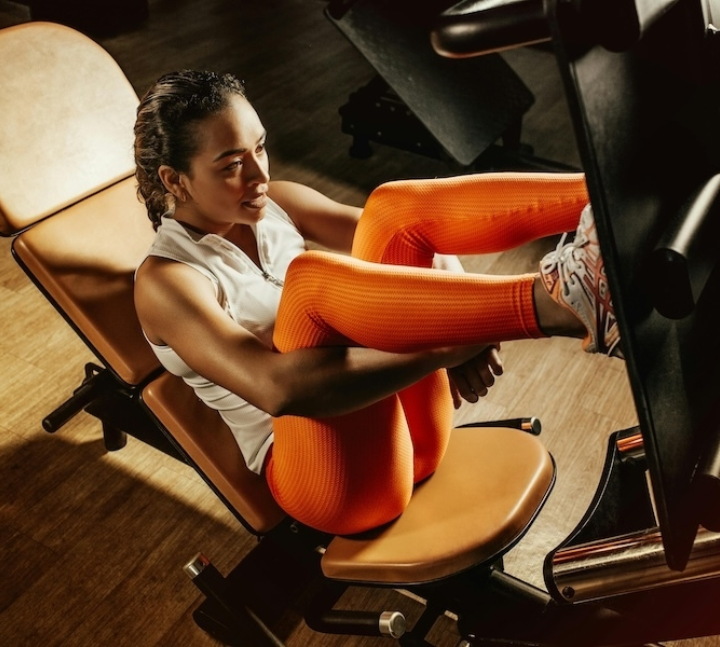Exercise
Lever Seated Hip Abduction
How to Perform - Lever Seated Hip Abduction
Sit on the machine and adjust the seat height so that your knees are aligned with the rotation point of the movement arms. Position your outer thighs against the pads.
Secure any safety belts across your lap, sit upright with your spine neutral, and grasp the handles or seat edges for stability.
Set your feet flat on the platform or footrests, keeping your ankles in a neutral position with knees bent at approximately 90 degrees.
Engage your core muscles to stabilize your pelvis and prevent unwanted movement in your lower back. Exhale as you prepare for the movement.
Push outward with your thighs, moving the weighted pads away from your center while maintaining contact between your back and the support pad. Exhale during this exertion phase.
Continue the outward movement until you feel tension in your outer hip muscles, avoiding pushing to the point of discomfort in your hip joints.
Hold the position briefly at the point of maximum comfortable resistance, maintaining your upright posture and keeping your core engaged.
Inhale as you slowly return to the starting position, controlling the weight and resisting the urge to let the pads snap back together.
Important information
- Keep your upper body relaxed but stable throughout the movement, avoiding the tendency to lean to one side as you push outward.
- Focus on using your hip abductor muscles (outer thigh) rather than pushing with your feet or knees.
- Adjust the resistance to a level that allows you to complete your target repetitions with proper form.
- If you experience any pinching or pain in your hip joint, adjust your position or reduce the range of motion to a comfortable level.
Primary Muscles
Muscle Groups
Mechanic
Risk Areas
Built for progress
Take the guesswork out of training
Create personalized AI-powered workout plans that evolve with you. Train smarter, track every rep and keep moving forward, one workout at a time.






The Lever Seated Hip Abduction machine is a valuable addition to any intermediate-level training program focused on isolating and strengthening the gluteal muscles and hip abductors. This specialized equipment offers a controlled environment to target these often-neglected muscle groups with precision and minimal risk of injury, making it particularly effective for both bodybuilding enthusiasts looking to develop balanced lower body aesthetics and those in recovery seeking to rebuild strength in a controlled manner.
Working primarily on the gluteus medius, gluteus minimus, and tensor fasciae latae (TFL), this exercise creates targeted tension through the entire range of motion that's difficult to replicate with free weights. The seated position provides stability for your core and lower back, allowing you to focus entirely on the lateral movement pattern that defines hip abduction. For bodybuilders, this translates to improved muscle definition along the outer thigh and hip region, contributing to that coveted X-frame physique where the hips create visual width in proportion to a tapered waist.
From a strength perspective, developing robust hip abductors plays a crucial role in overall lower body performance and functionality. These muscles provide lateral stability during walking, running, and complex movements like squats and lunges. Stronger abductors can correct muscle imbalances that often develop when training focuses exclusively on forward movements, potentially reducing knee and hip pain associated with these imbalances.
The machine's adjustable resistance makes it particularly valuable for progressive overload—a fundamental principle for strength development. You can systematically increase the challenge as your muscles adapt, ensuring continued growth and strength gains. For those in recovery phases, the controlled nature of the movement allows precise loading that can be carefully monitored and adjusted based on rehabilitation protocols.
Incorporating the Lever Seated Hip Abduction into your routine 1-2 times weekly can yield noticeable improvements in hip stability, glute activation, and overall lower body strength, while creating more balanced muscular development throughout the hip complex.
FAQ - Lever Seated Hip Abduction
The Lever Seated Hip Abduction primarily targets the gluteus medius, gluteus minimus, and tensor fasciae latae (TFL). These muscles are responsible for moving your leg away from the midline of your body and providing lateral stability during lower body movements.
For optimal results, include the Bodyweight Single Leg Deadlift 1-3 times weekly, performing 2-3 sets of 8-12 repetitions per leg. This frequency provides enough stimulus for strength development while allowing adequate recovery, especially if you're also doing other posterior chain exercises.
Avoid bending your elbows to compensate for limited shoulder mobility, as this negates the stretching benefits. Don't rush through repetitions or use momentum—move slowly and deliberately. Also, never force the movement beyond the point of mild discomfort, as this could lead to shoulder strain.
Increase difficulty by adding isometric holds at the fully abducted position for 2-3 seconds before returning to the start position. You can also perform drop sets by completing a set at a challenging weight, then immediately reducing the weight and continuing until muscle fatigue.
Yes, strengthening your hip abductors significantly improves knee stability by enhancing lateral control during movements. Strong hip abductors help maintain proper knee alignment during walking, running, and other activities, potentially reducing the risk of common knee injuries and pain syndromes.







